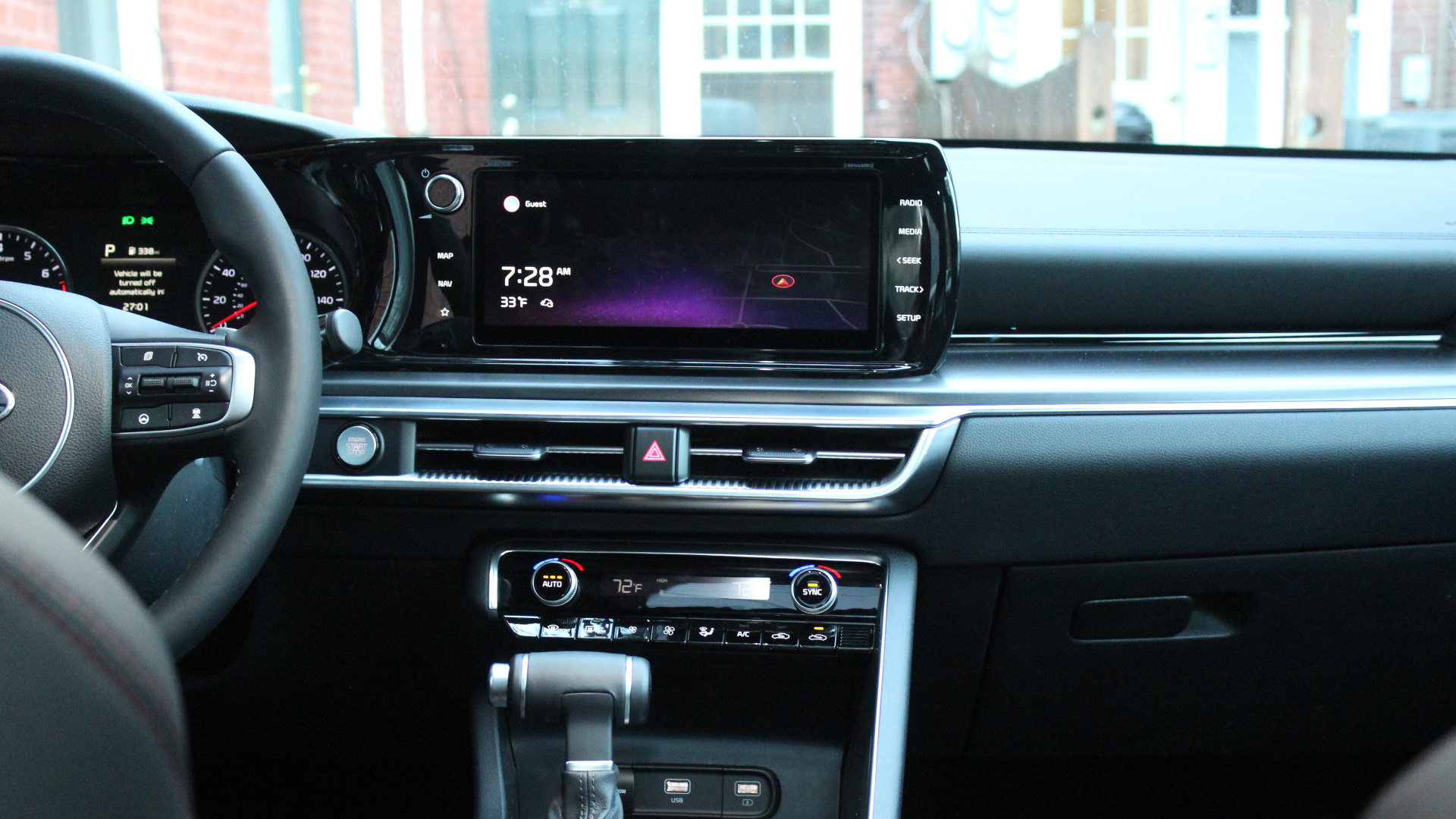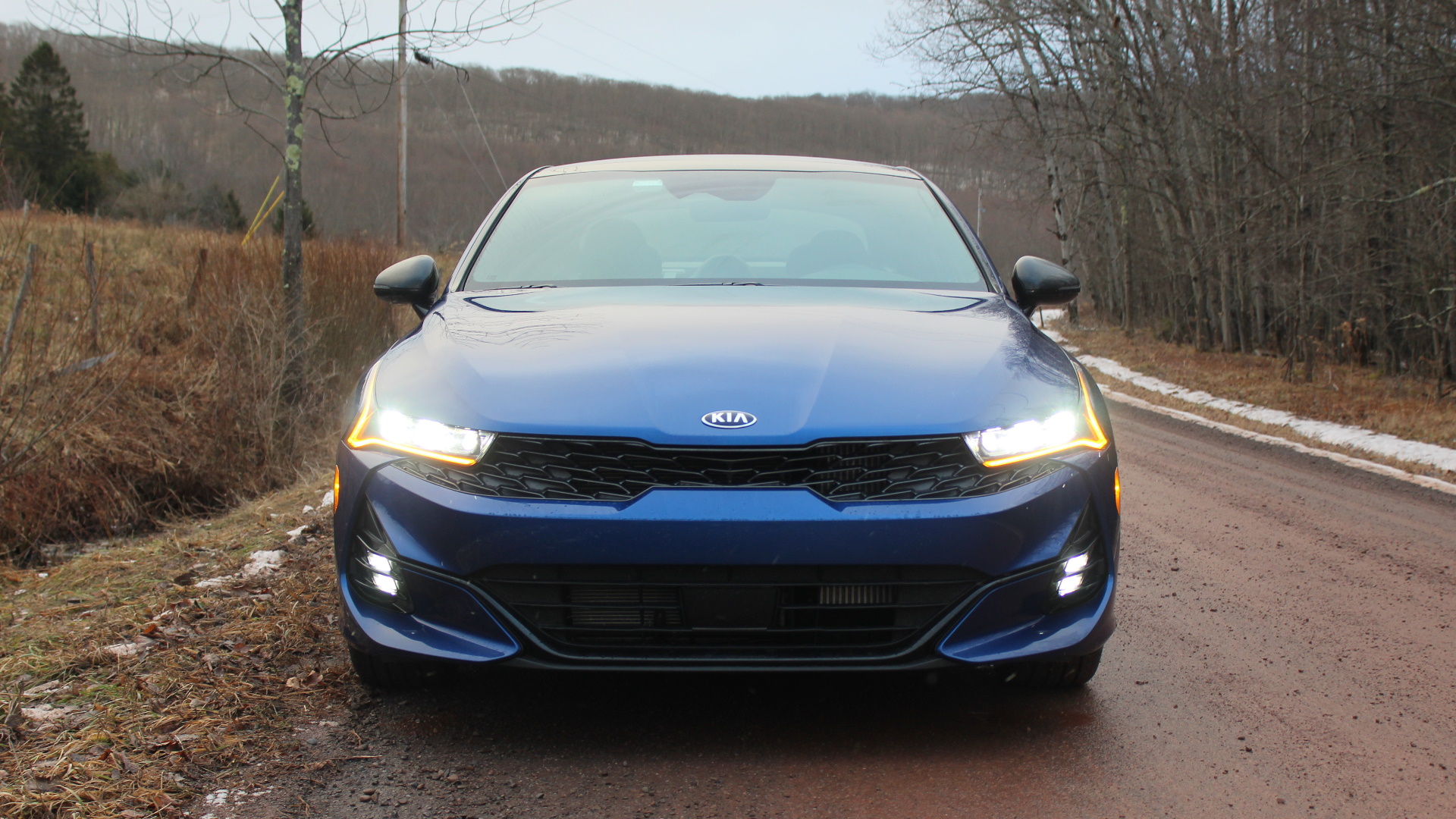The Kia K5 used to be called the Optima, and it’s kind of hard to believe that in one generation it’s gone from what was basically an off-brand Camry to something like this, a car that compromises in the best ways possible. It’s easy to say that it’s better to drive and much better value than something like a lower-spec BMW 3 Series. Figured I’d get some big truths out of the way up front.
And that’s despite the talk of the latest G20-generation 3 Series being a return to the form for the segment-leading driver’s sedan. BMW may be trying to get its mojo back, but key parts of the K5 from the engine to the transmission are just stronger. The eight-speed dual-clutch upshifts hard in Sport+ mode, downshifts smoothly in any mode—there’s also Sport and Normal—and is always civilized, always responsive, always does what you want it to do. The 2.5-liter turbocharged engine has tremendous torque—311 lb-ft, nearly off idle. It’s smooth, sounds good, and you’ll notice its 290 horsepower is very near 300. It feels like that much.

But the best part of all is that the K5 GT isn’t trying to be something for everybody. The steering is communicative and quick, and the chassis feels tuned for people who specifically want to drive. It’s firm and confident, and one of the key parts that make this car what it is: an excellent sports sedan.
The 2021 Kia K5 GT, By the Numbers
- Base Price (As Tested): $31,455 ($35,705)
- Powertrain: 2.5-liter turbocharged inline-four | eight-speed dual-clutch automatic transmission | front-wheel-drive
- Horsepower: 290 horsepower @ 5,800 RPM
- Torque: 311 pound-feet @ 1,650-4,000 RPM
- EPA Fuel Economy: 24 mpg city | 32 highway | 27 combined
- Curb Weight: 3,534 pounds
- 0-60 mph: 5.7 seconds
- Quick Take: Spiritually, this car is more of a BMW than Munich can muster right now—even without RWD.
Inside and Out, K5 GT Measures Up
If it was between buying this or a 3 Series for the same money, the choice would still be pretty easy, but obviously these two cars aren’t sold for the same money. You can get equipment on the Kia you simply can’t get on the cheapest 3er—ventilated seats being the prime example—for $6,000 less. In fact, there’s really only one package to be had; the GT1 package. It increases the K5 price to right around $35,000 and includes Kia’s excellent “Highway Driving Assist” with lane keep and radar cruise control, a heated steering wheel, ventilated seats, and more. Unless you really want something like a cargo net, which you might actually want to spring for because this car’s trunk is massive, the GT1 package is really all you need.
Other interior equipment that comes with the GT1 package includes a Bose sound system—that pipes in engine noise at the same volume no-matter-what mode you’re in—a reactive and lag-free 10.25-inch touchscreen, satellite radio, and a power front passenger seat with adjustable lumbar, just like the driver’s. Just getting the GT trim of this car also nets you fake leather seats, a GT-exclusive flat-bottom steering wheel with very reactive paddle shifters, heated seats, and a wireless phone charging slot. Your rear passengers will also get an HVAC vent.




Are there bad parts? Yeah, sure. It’s nothing you’re not going to get used to, though. Easily the worst thing about this car—just to show you how nit-picky one really has to be—is the shifter. It looks bad. It also feels bad. If I was in charge of facelifting this car I’d throw it in the neighbor’s pool. Complaints could also be leveled that the seats, not because they’re necessarily extremely uncomfortable, but they aren’t living up to this car’s other excellent parts. They feel a little flat despite being heated and ventilated, and this car really deserves more. Recaros are in order here.
The menu for switching media inputs is also quite hidden, and if you have no media device selected, it defaults to “Sounds of Nature.” It’s sort of a funny thing the first time, but after a while hearing a “Lively Cafe” or “Snowy Village” every time your phone fails to connect to Bluetooth gets a little old. Besides that, everything in the interior feels great. Nothing you can see or touch looks cheap, rough, hollow, or unpleasant. Besides that shifter, of course.
Also, if we’re gonna talk about things you can see and touch, the outside of this car looks great. The rear end isn’t quite as wide as it tries to look—there’s still some economy car going on there—but the styling is aggressive, distinctive, and consistent throughout the entire exterior. I know that people are gonna have different opinions, but from where I’m standing, it’s just right.




Driving the 2021 Kia K5 GT
I’ve spoken to the drivetrain and chassis a little bit, but how it all translates on the road is where Kia’s vision for a 3 Series fighter comes into focus. First of all, the suspension is approaching the stiffness of cars like my E46 M3; I understand that sounds like a stretch, but that truth was right there before me. It’s a welcome change from other cars that try to be right on the edge of stiff, but compromise in the end to maintain a level of comfort. The 19-inch wheels probably contributed to the harder ride too.
As a result of this tautness, cornering is flat, changes of direction are quick and drama-free, and the steering—2.44 turns lock-to-lock instead of 2.60 on a regular K5—points the car’s nose where you want with surprising precision. And as I mentioned it also has a fair amount of feel, meaning you won’t lose track of the front end mid-corner due to sheer numbness. It’s that directness (and FWD setup) that makes it easier to actually wring the most out of the car’s powertrain in more situations, even on slippery dirt roads.

Speaking of that, to the rear-wheel-drive zealots: know that about 95 percent of the time, you don’t realize this car is front-wheel drive because it has practically no torque steer, plenty of dry traction and a lovely sharpness to its movements. The onset of understeer is both predictable and avoidable, and it’d be even more limited on real summer tires in warm weather.
The brakes are also larger than stock, with 1.6-inch larger rotors in the front and rear—13.6-inches and 12.8-inches, respectively—leading to excellent, predictable stopping with good feel through the pedal. They’re one of the various upgraded parts of the car that could easily be forgotten about due to the GT’s status as just another trim level of a K5, but plenty of other small performance changes have also been made like wider wheels and tires, and a slightly higher cooling capacity.
Combine this low-slung, agile-handling chassis with an engine that yanks you out of a corner exit and a transmission that slams shifts when you demand it, and this Kia always feels ready for a fight. I haven’t driven this and a 3 Series back-to-back, but Editor-In-Chief Kyle Cheromcha has, and he says the Kia’s neutral handling and impressive stability are a night and day difference compared to the more skittish BMW.
The only thing really missing here is a limited-slip differential, and while the K5 GT does transfer torque around with help from the ABS system—as many other cars do—this Kia is worthy of the real deal, and it should at least be an option when the facelift comes around.

That missing LSD belies the reality that this isn’t one of those competition-tuned cars that’s supposed to pull double duty as a commuter and a hot lapper—you’ll have to check out Hyundai’s N performance cars for that. Kia’s GT label is akin to Hyundai’s N-Line designation, for peppy daily drivers with mechanical flair like a DCT, not hunkered-down track animals like the Hyundai Veloster N. You’d cook the K5 GT’s brakes in short order on a road course. But that’s not the point of the car.
Verdict
A lot of cars sold today are trying to please everybody. This Kia definitely isn’t. It’s trying to please people who drive for the sake of driving, but at the same time because of the great driver assist technology and the really fantastic 8-speed dual-clutch transmission (I know I keep talking about it, but it really is something), it’s perfectly fit for every day. At this point, you can probably tell that during my time with the 2021 Kia K5 GT, I had no problem living with it. I would have kept it for longer if I could. Compared to other similar sport sedans being sold for a lot more money, this car is more fun, it’s more powerful, and if you really want, you can get it for $31,455.
Brand image is an incredibly stubborn thing, and to some the $10,000+ premium is worth stepping up to even the cheapest 3 Series instead of this car. I get that. But I also can’t get around the fact that BMW is charging that much more for a car that is objectively—as we know—and subjectively worse than the Kia. Of course a new M3 would blow this out of the water, and even an M340i. But those are different beasts in a different price range. And really, isn’t the fact that we’re having this conversation at all extremely telling?
While I might be angering people, you could consider it a slightly pricier alternative to something like a GTI or even a base WRX, which is a full three tenths of a second slower to 60 mph despite being all-wheel drive. Buy a Civic Si if you want a manual transmission—which this car really doesn’t need—but absent that, it’s hard to argue against what Kia’s done here.
Except, now I’m thinking about an AWD K5 GT, which is not entirely out of the question. Kia already makes an AWD version of the K5. This powertrain hitting all four wheels on a snowy road? I hope it’s in the cards.
Do you have any additional questions about the K5 GT? Send me a message: peter@thedrive.com
